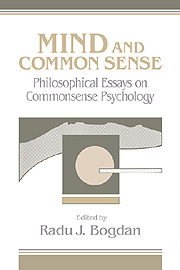Book contents
- Frontmatter
- Contents
- List of Contributors
- 1 The Folklore of the Mind
- 2 Analysis without Noise
- 3 Folk Psychology and the Explanation of Human Behavior
- 4 Methodological Reflections on Belief
- 5 Consciousness and Content
- 6 The Inevitability of Folk Psychology
- 7 How is Eliminative Materialism Possible?
- 8 The Long Past and the Short History
- 9 Common Sense Naturalized: The Practical Stance
- Index
7 - How is Eliminative Materialism Possible?
Published online by Cambridge University Press: 24 September 2009
- Frontmatter
- Contents
- List of Contributors
- 1 The Folklore of the Mind
- 2 Analysis without Noise
- 3 Folk Psychology and the Explanation of Human Behavior
- 4 Methodological Reflections on Belief
- 5 Consciousness and Content
- 6 The Inevitability of Folk Psychology
- 7 How is Eliminative Materialism Possible?
- 8 The Long Past and the Short History
- 9 Common Sense Naturalized: The Practical Stance
- Index
Summary
Eliminative materialism is the thesis that our common-sense conception of psychological phenomena constitutes a radically false theory, a theory so fundamentally defective that both the principles and the ontology of that theory will eventually be displaced, rather than smoothly reduced, by completed neuroscience.
The trouble with this bald claim is that it threatens eliminative materialism (EM) with unbelievability, unassertability, evidential groundlessness, self-stultification, self-referential falsehood, and other defects. The allegation is widely known: A sentence expressing the thesis of eliminative materialism would be just a concatenation of ink marks or a bare acoustical disturbance unless it meant something. But for inscriptions or vocalizations to mean anything they must have the right causal provenance, one that involves intentional states of various kinds in myriad possible ways. Moreover, assertions are actions, but actions are caused by desires and beliefs. Additionally, nothing could be evidence for a thesis unless there are agents who recognize it as evidence. Since eliminative materialism expressly denies the existence of beliefs and desires, and thereby precludes assertions and all other actions, as well as evidence for or against anything, it follows that its truth cannot be asserted, believed, hoped for, substantiated to any degree by any evidence, or rationally defended. Call this the incoherence problem.
The incoherence problem has rarely been a serious issue between defenders of EM (hereafter EMists) and their opponents.
- Type
- Chapter
- Information
- Mind and Common SensePhilosophical Essays on Common Sense Psychology, pp. 123 - 143Publisher: Cambridge University PressPrint publication year: 1991
- 1
- Cited by



